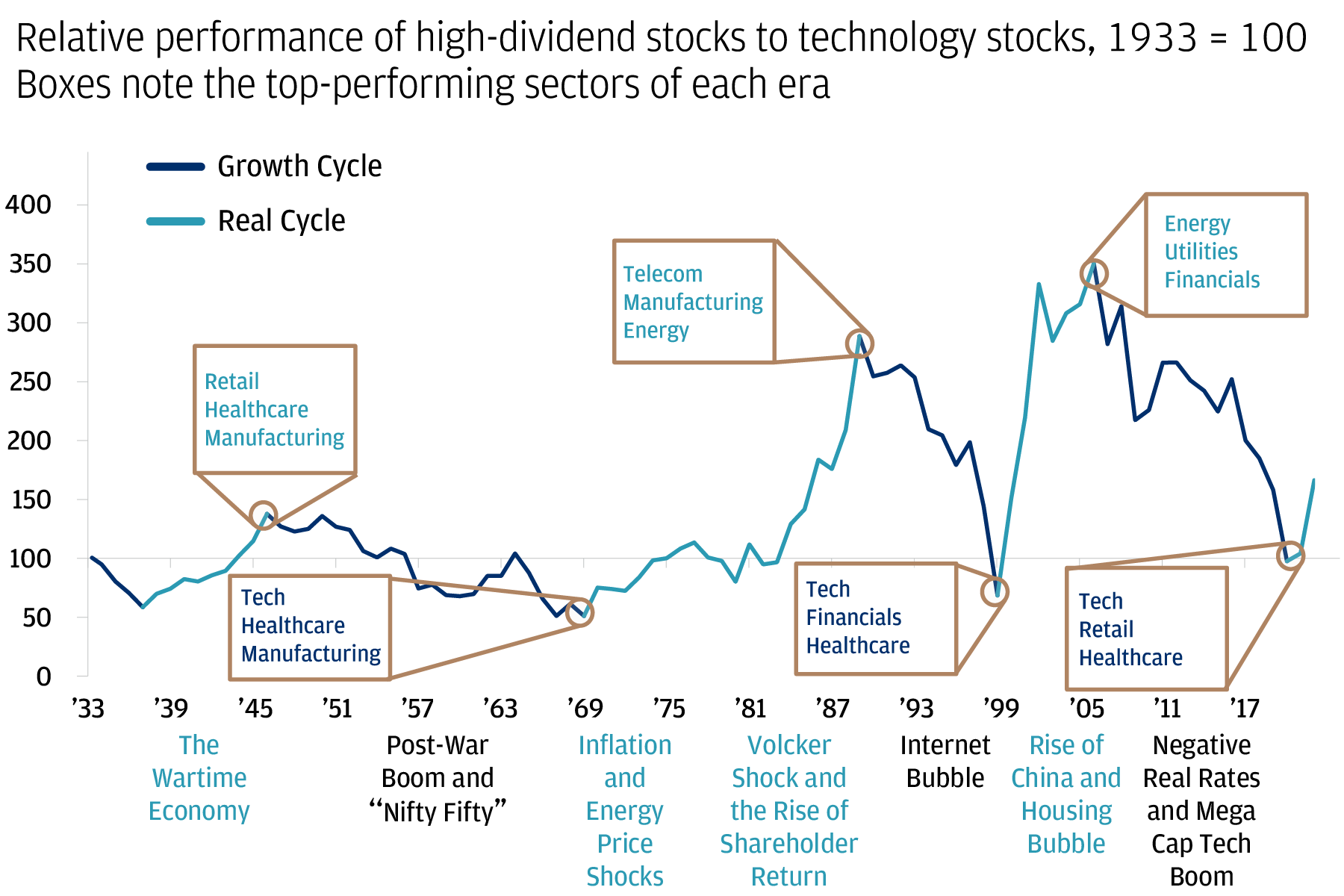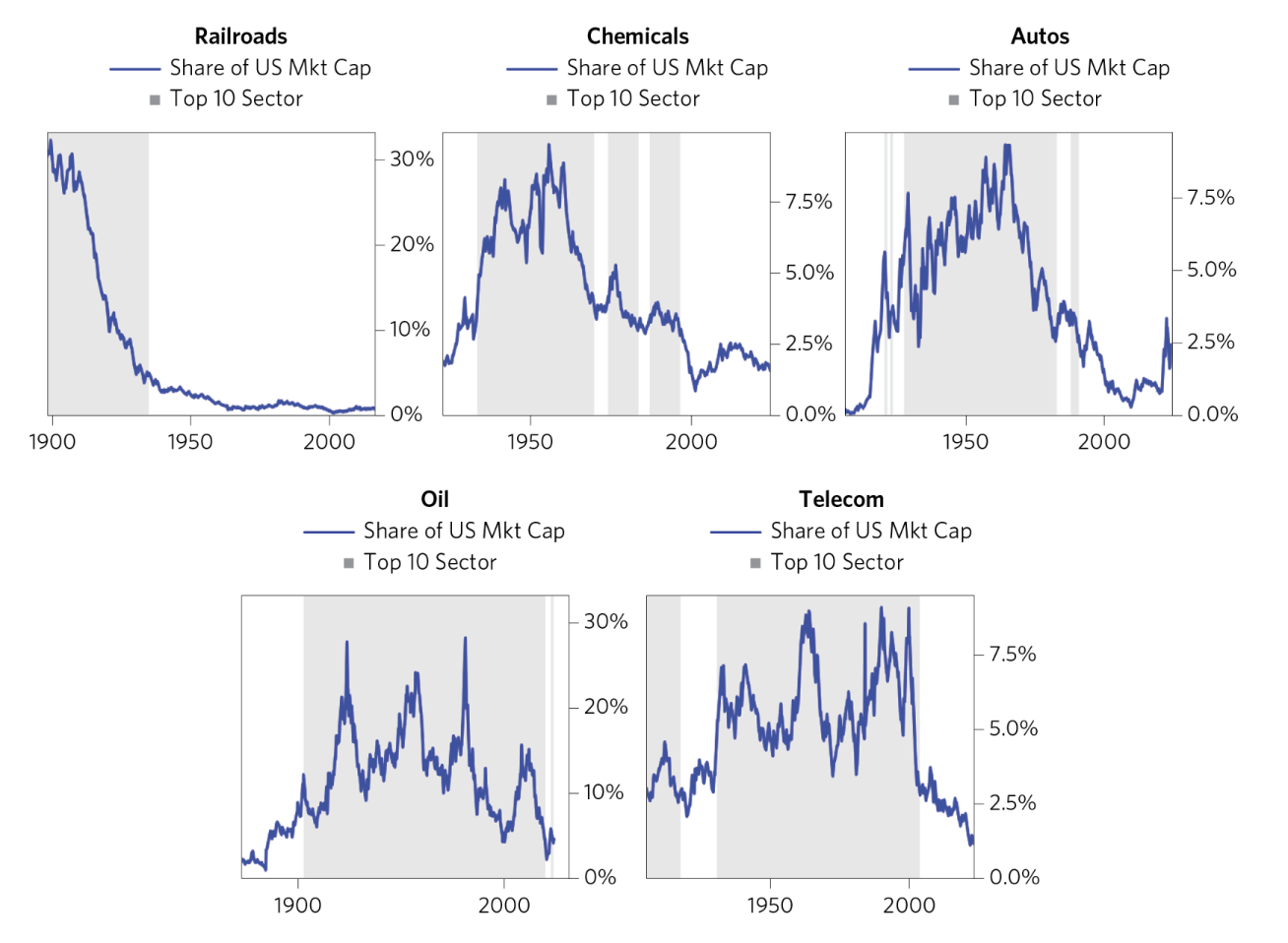What creates the next great "market champion"?
For instance, during the very end of the ultra-low inflation and near-zero interest credit era, it made sense for a business like Afterpay to flourish, and for investors to gravitate towards it, or when geopolitical uncertainty grips markets, it makes sense for energy and gold companies to receive a lot of inflows. And, as I've heard a fundie or two say before, when everyone thinks it will never rain again, you buy agricultural stocks.
And in this first of a two-part wire series, we will discover what turns a market darling into a market champion.
It wasn't always like this...
But it wasn't always this way. This JPMorgan chart shows how the US stock market's leadership tends to gyrate between stocks that benefit from growth-oriented names and value-oriented names.

"While the timeline of each cycle is highly uncertain, the vast majority have eventually succumbed to new entrants. Some have gone to zero; some are still relevant today but have underperformed the broader market," Bridgewater analysts led by co-CIO Bob Prince wrote.
They provide the following changes as examples:
- Railroad monopolies of the 1900s to the 1930s
- Chemical conglomerates of the 1930s to the 1960s
- Auto conglomerates of the 1920s to the 1960s (General Motors (NYSE: GM))
- Oil/Energy companies of the 1900s through the present (Exxon Mobil (NYSE: XOM), Chevron (NYSE: CVX), etc.)
- Telecoms from the 1930s to 2000s (AT&T (NYSE: T))
But in every case, each industry was dealt a slow but steady decline in its influence on the stock market.

Today's world
"In terms of pricing, we see meaningful divergences within the cohort of current champions—in some cases, valuations look consistent with these companies' strong prospects, and in other cases, more outperformance than is likely looks priced in," they said.
But what about in Australia?
But he also argued you'd be hard-pressed to find a time where the financials (CBA, ANZ, Westpac, NAB) and at least one mining stock (namely BHP) have not been the lynchpins of the All Ordinaries since it launched in December 1979 - or the ASX 200 since it launched in April 2000.
Why is that?

"Australia has historically possessed a strong protectionist mindset, and this has been reflected in our economic policies. For instance, the '4 pillars' federal policy that applies to the four major banks was put in place ostensibly to maintain a competitive financial services sector," Datt said.
"However, the unintended consequences of this policy have been to entrench an oligopolistic industry structure in which it's almost impossible to displace any of the incumbents."
Justin Teo, Analyst and Portfolio Manager at Fidelity International, expresses a similar view:
"Australia is blessed with a large natural resource endowment which, combined with a relatively stable political environment, has allowed the country to build decades of expertise in mining," Teo said.
"The banking sector is very concentrated in Australia, as it’s an industry where scale matters. Macquarie is successfully disrupting the mortgage market in Australia, however, this is only possible because it has large businesses outside of mortgages to fund this disruption," he added.
Luke Laretive, CEO and Investment Adviser at Seneca Financial Solutions takes a different tack.
"20% of the index are the Big Four banks operating in a regulated oligopoly. It's unlikely this dynamic will be materially disrupted while APRA requires more capital from anyone else who wants to write a loan. Then, there are a couple of ex-government entities in CSL and Telstra. The miners - BHP, Rio Tinto, Fortescue, Woodside, and Santos - leverage the natural competitive advantage under our feet and on our ocean floors. Throw in the supermarkets and a toll road, which are all regulator-supported."
- Macquarie Group (ASX: MQG)
- Goodman Group (ASX: GMG)
- Aristocrat Leisure (ASX: ALL)
- Wisetech (ASX: WTC)
- REA Group (ASX: REA)
But whatever the reason, it's likely the dominant players in the market won't change anytime soon. And even if they stay the same, there are still great ideas underneath the surface. After all, given that Commonwealth Bank is the most expensive bank in the world (according to the MSCI World Bank Index), it's not exactly destined to become a 10-bagger.
That's where part two of this series comes in. Datt, Teo, and Laretive will join us in our next wire to share the traits they look for in a future market champion - and to name one they are looking at themselves.
20 stocks mentioned
3 contributors mentioned

